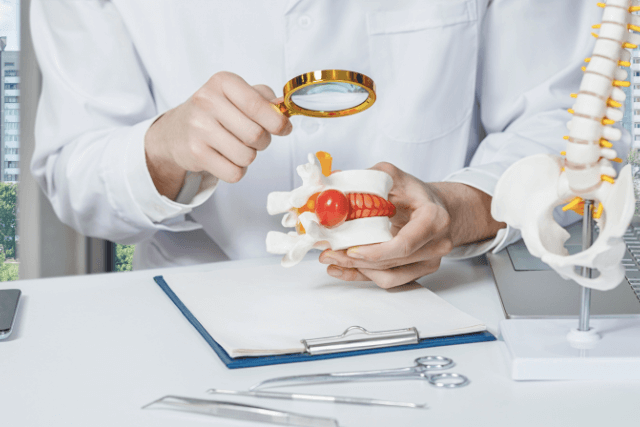Hernias are a common health condition that many people encounter, yet they are often misunderstood. You may have heard the term “hernia” mentioned by a doctor or read about it in medical articles, but what causes a hernia, and why do some people develop it while others don’t? This blog will help you understand the root causes and risk factors of hernias, including how lifestyle, genetics, and certain activities contribute to their development. Moreover, we will explore how you can reduce your risk and manage the condition effectively.
What Causes a Hernia? Understanding the Basics
To start, it is essential to grasp what a hernia is and how it forms. A hernia occurs when an organ or fatty tissue pushes through a weak spot or opening in the muscle or connective tissue surrounding it. This often happens in areas of the body like the abdomen, groin, or upper thigh.
Hernias are categorized based on where they occur in the body. Common types include:
- Inguinal Hernia: Occurs in the groin area.
- Femoral Hernia: Found in the upper thigh or groin.
- Umbilical Hernia: Develops near the belly button.
- Hiatal Hernia: Happens when part of the stomach pushes up into the chest cavity.
- Incisional Hernia: Occurs at the site of a previous surgical incision.
Now that we know what a hernia is, the next question is, what causes a hernia to develop in the first place? Generally, a hernia forms due to pressure on an area of the body where the muscle or connective tissue has weakened. But there are various factors that contribute to this weakening, which we’ll explore in detail.
Root Causes of a Hernia
There are multiple reasons why what causes a hernia can vary from person to person. Below are the most common causes of hernias:
Increased Abdominal Pressure
Increased pressure in the abdomen is the primary cause of most hernias. Anything that increases this pressure can lead to a hernia. Some of the most common factors include:
- Heavy Lifting: Lifting heavy objects improperly can put undue strain on your abdominal muscles, leading to a hernia.
- Coughing or Sneezing: Chronic coughing or sneezing, especially if it’s violent, can create constant pressure on the abdominal wall.
- Constipation: Straining to pass stools can also increase abdominal pressure, contributing to the development of a hernia.
- Obesity: Being in a higher-weight body puts excess pressure on the abdominal wall, making it more prone to hernia formation.
- Pregnancy: As the abdomen expands to accommodate a growing baby, the muscles and tissues stretch, which can cause a hernia, particularly in the abdominal and groin areas.
Weakness in the Abdominal Wall
The second leading cause of hernias is a weakness in the abdominal wall. This can either be congenital (present from birth) or develop over time due to aging or lifestyle factors. As people age, their tissues become weaker and less elastic, making it easier for a hernia to form.
Certain individuals may also be born with a weak spot in their abdominal wall, which increases their risk of developing a hernia. However, not everyone with a weak spot develops a hernia, suggesting that increased pressure and other factors also contribute.
Previous Surgical Incisions
Another cause of what causes a hernia is a previous surgery. When you undergo surgery, the doctor often makes an incision in the skin and muscles. Over time, these incisions can weaken the surrounding muscles, leaving an area more susceptible to hernia development. This is known as an incisional hernia.
Risk Factors for Hernias
While hernias can affect anyone, certain factors make some individuals more vulnerable. Here are the key risk factors that can increase your chances of developing a hernia:
- Age: As mentioned earlier, aging weakens the muscles and tissues, which increases the risk of hernia formation. Older adults are generally at a higher risk of developing hernias, especially in the abdominal and groin areas.
- Genetics: Some people inherit a predisposition to weakened connective tissue, which increases their likelihood of developing hernias. If your family has a history of hernias, you might be more likely to develop one yourself.
- Gender: Men are more likely to develop inguinal hernias than women. This is because men have a natural weakness in their abdominal walls, a condition that may be exacerbated by factors like heavy lifting or other physical activities.
- Chronic Health Conditions: Certain medical conditions that lead to chronic pressure on the abdominal region can increase the likelihood of hernias. For example, conditions like chronic obstructive pulmonary disease (COPD), asthma, or cystic fibrosis can cause frequent coughing, which increases abdominal pressure.
- Smoking: Smoking weakens the connective tissues and slows down the healing process, making it more difficult for muscles to recover from the stress they experience during daily activities. Smokers also tend to cough more, which adds pressure to the abdominal wall.
- Pregnancy: As mentioned earlier, pregnancy increases the likelihood of developing a hernia due to the physical strain placed on the abdominal muscles. Women who have had multiple pregnancies may be at a higher risk.
- Obesity: Excess weight can lead to increased pressure on the abdominal wall, making it more prone to hernia formation. Obesity can also contribute to other risk factors like chronic coughing or difficulty with bowel movements.
Types of Hernias and Their Causes
Each type of hernia has its own unique causes, although they all share a similar mechanism involving increased pressure and weakened muscles. Let’s take a closer look at the different types of hernias and what causes each one.
Inguinal Hernia
An inguinal hernia is the most common type, occurring in the groin area. It typically happens when a part of the intestines or fatty tissue pushes through the abdominal wall or the inguinal canal (a passageway in the groin). The main cause of an inguinal hernia is increased pressure in the abdomen due to factors like heavy lifting or obesity.
Femoral Hernia
A femoral hernia occurs just below the inguinal ligament in the upper thigh. It is more common in women and occurs when tissue, such as part of the intestine, pushes through a weakened area in the femoral canal. Like the inguinal hernia, increased abdominal pressure is a key contributor.
Umbilical Hernia
An umbilical hernia happens near the belly button. It occurs when part of the intestines or fatty tissue bulges through a weak spot in the abdominal muscles. This type of hernia is often seen in newborns but can also affect adults, especially those with higher body weight or individuals who have had multiple pregnancies.
Hiatal Hernia
A hiatal hernia occurs when part of the stomach pushes up through the diaphragm into the chest cavity.Factors like age, higher weight, and increased pressure from coughing or straining can contribute to hernia formation.
Incisional Hernia
An incisional hernia forms at the site of a previous surgical incision. After surgery, the muscles in the abdominal wall may not fully heal, leading to the formation of a bulge or hernia. This type of hernia is more common in people who have had major abdominal surgeries.
How to Prevent a Hernia
Preventing a hernia is not always possible, especially when it comes to factors like age or genetics. However, you can significantly reduce your risk by following a few simple guidelines:
- Maintain a Healthy Weight: Keeping your weight within a healthy range reduces the pressure on your abdomen and helps prevent hernias.
- Lift Properly: Always use your legs, not your back, when lifting heavy objects. Avoid lifting objects that are too heavy for you, and when lifting, make sure to squat rather than bending at the waist.
- Eat a Healthy Diet: A diet rich in fiber can prevent constipation and reduce straining during bowel movements, which can contribute to the development of hernias.
- Quit Smoking: Smoking weakens connective tissue and causes frequent coughing, which can increase your risk of developing a hernia.
- Exercise Regularly: Regular physical activity helps strengthen your abdominal muscles, reducing the likelihood of developing a hernia.
Conclusion: What Causes a Hernia?
In summary, what causes a hernia is a combination of factors, primarily the increased pressure on a weak spot in the muscle or connective tissue. Conditions like obesity, heavy lifting, chronic coughing, and certain health conditions can increase the risk of a hernia. Additionally, factors like aging, genetics, and previous surgical incisions can further predispose you to this condition.
While not all hernias are preventable, maintaining a healthy lifestyle can significantly reduce your risk. If you suspect a hernia or symptoms, consult a healthcare professional for proper diagnosis and treatment.
By understanding the root causes and risk factors associated with hernias, you can take steps to prevent them and seek timely medical care if needed.










